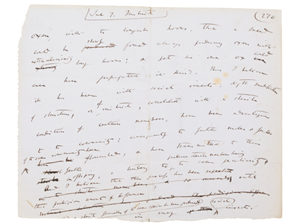
Autograph manuscript, title "Sect 7. Instinct", being the page numbered "270" from the manuscript of on the origin of species by means of natural selection. (Circa 1858).
In this chapter, Darwin discusses the inheritability of instinct and its role in natural selection. Instinct proves difficult for Darwin to define. It is similar to habit, because it consists of actions performed repeatedly by an individual animal. But unlike habit, which Darwin believes animals learn, instinct is inherited. The causes of innate instincts remain unknown, in the same way the causes of physical variations are unknown. Darwin believes that inherited habits—those learned by a parent and subsequently passed on to offspring by hereditary inheritance—may play a role in the construction of these instincts. However instincts come to be, Darwin argues that natural selection acts on them just as it acts on physical variations. If an instinct is advantageous to a species’ survival, natural selection allows organisms with that instinct to survive over others and perpetuate that instinct in their offspring. Thus, natural selection helps create entire species with well-adapted instincts, allowing them to survive in a variety of natural environments.
The text of the manuscript differs with the printed version of the first edition.
The present page is one of a handful of scattered leaves that survive from the manuscript that Darwin rushed to complete in the second half of 1858. (Just five different leaves have appeared at auction in the last three decades.) Although Darwin had assimilated the researches and observations from his five years as naturalist aboard the survey ship H.M.S. Beagle into the essential formulation of his theory of natural selection by the late 1830s, he was finally spurred to publish after Alfred R. Wallace independently came to a nearly identical conclusion about the transmutation of species. Charles Lyell and Joseph D. Hooker arranged for papers by both Darwin and Wallace to be published in the 20 August 1858 issue of the Journal of the Proceedings of the Linnean Society. Once Wallace's article, "On the Tendency of Varieties to Depart Indefinately from the Original Type" was printed, Darwin rushed to prepare for publication an epitome of the "big species book" that he had been working on since 1856. (Darwin's initial suggestion for a title, An Abstract of an Essay on the Origin of Species and Varieties, was rejected by his publisher as too tentative.)

Originally conceived as a work that might be printed on four or five sheets of paper, On the Origin of Species evolved during the eight months of its writing into a volume of nearly 500 pages. The final scope of Origin of Species prompted Darwin to abandon plans for his "big species book," but he salvaged much of the first part of the manuscript for The Variation of Animals and Plants under Domestication, published in 1868.
More information is here.

ArtDependence Magazine is an international magazine covering all spheres of contemporary art, as well as modern and classical art.
ArtDependence features the latest art news, highlighting interviews with today’s most influential artists, galleries, curators, collectors, fair directors and individuals at the axis of the arts.
The magazine also covers series of articles and reviews on critical art events, new publications and other foremost happenings in the art world.
If you would like to submit events or editorial content to ArtDependence Magazine, please feel free to reach the magazine via the contact page.